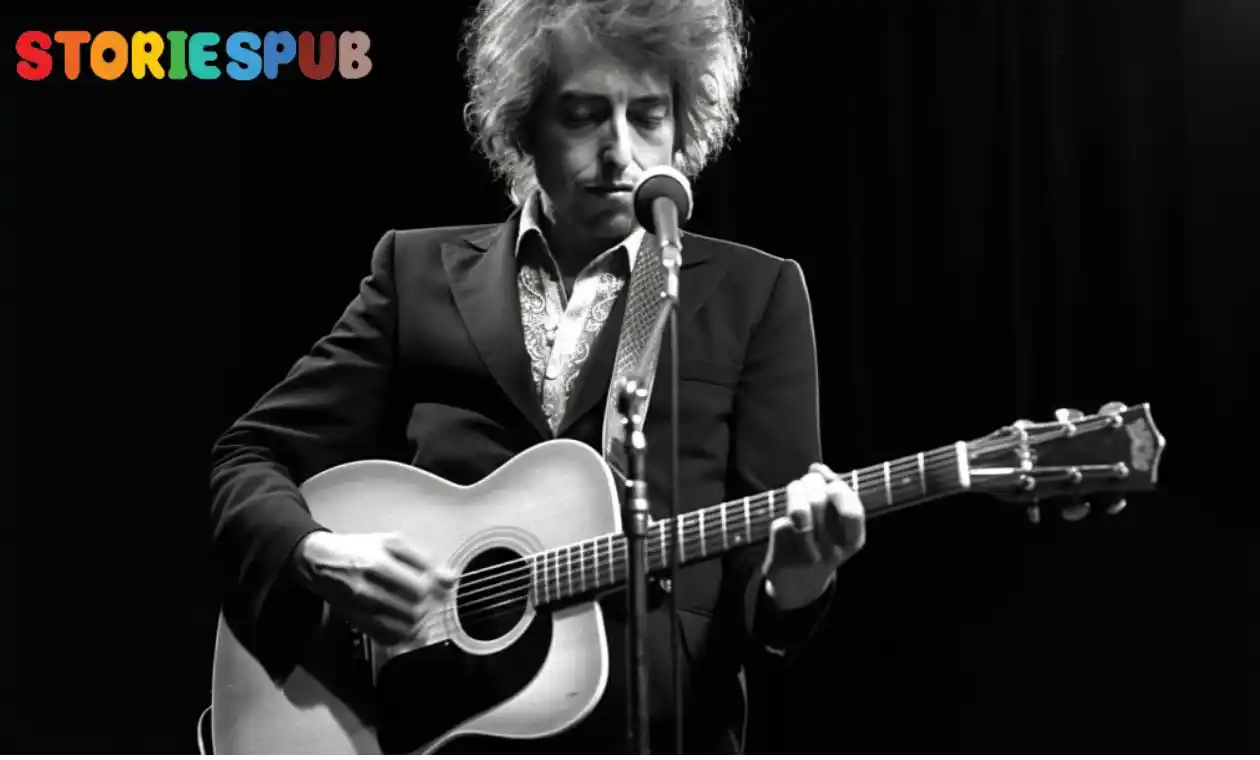Bob Dylan’s Biography: A Songwriter’s Journey to Greatness

Bob Dylan, a name synonymous with artistic brilliance and poetic expression, stands tall as a legendary singer-songwriter and an enduring cultural icon. With a career spanning over six decades, Dylan has left an indelible mark on the world of music and beyond. From his humble beginnings in Hibbing, Minnesota, to becoming a global sensation, Dylan’s journey has been nothing short of extraordinary.
Renowned for his distinctive raspy voice, profound lyrics, and magnetic stage presence, Dylan emerged during the folk music revival of the 1960s. His songs became anthems of social change, speaking to the hopes, frustrations, and aspirations of an entire generation. With timeless classics like “Blowin’ in the Wind” and “Like a Rolling Stone,” Dylan’s artistry resonated deeply, capturing the spirit of the era and catapulting him into the realm of musical immortality.
Dylan’s legacy extends to his role as a cultural trailblazer, influencing generations of artists across genres. His exploration of various musical styles and poetic themes pushed boundaries and expanded the possibilities of songwriting. Recognized with numerous accolades, including the Nobel Prize in Literature, Dylan continues to inspire with his creativity, intellect, and unwavering commitment to his craft.
In this biography, we delve into the life and career of Bob Dylan, exploring the man behind the music and unraveling the threads of his enduring influence on folk music and popular culture.
Personal and Professional Details
| Full Name | Robert Allen Zimmerman |
| Stage Name | Bob Dylan |
| Date of Birth | 24-May-41 |
| Place of Birth | Duluth, Minnesota, United States |
| Nationality | American |
| Occupation | Singer-songwriter, Musician, Artist, Writer |
| Instruments | Guitar, Harmonica, Piano |
| Genres | Folk, Rock, Blues, Country |
| Labels | Columbia Records, Asylum Records |
| Years Active | 1961 – Present |
| Notable Works | Blowin’ in the Wind, “Like a Rolling Stone” |
| Awards and Honors | Nobel Prize in Literature, Grammy Awards |
| Philanthropy | Supporter of various charitable organizations |
| Website | Official Bob Dylan website |
Early Life and Musical Beginnings
Born as Robert Allen Zimmerman on May 24, 1941, in Duluth, Minnesota, Bob Dylan’s journey began in a small town that would shape his perspective and fuel his artistic fire. Raised in a Jewish family, Dylan’s upbringing provided a backdrop of cultural richness and a sense of community.
Dylan showed a keen interest in music. His passion was ignited by the radio, where he soaked in the sounds of folk, blues, and country. Inspired by artists like Woody Guthrie, Hank Williams, and Lead Belly, Dylan picked up the guitar and harmonica, eager to craft his melodies and lyrics.
Dylan’s musical curiosity led him to explore the vibrant folk scene in New York City’s Greenwich Village. It was here that he adopted his stage name, Bob Dylan, paying homage to the Welsh poet Dylan Thomas. Immersed in the thriving folk music community, Dylan absorbed the storytelling traditions and the spirit of social activism that would come to define his music.
Dylan’s talent and unique approach to songwriting quickly caught the attention of industry insiders. His debut album, “Bob Dylan,” released in 1962, showcased his poetic lyrics and distinctive vocal style. As he embarked on his musical journey, Dylan’s songs became a soundtrack for the turbulent times, addressing themes of civil rights, war, and societal change.
With his sophomore album, “The Freewheelin’ Bob Dylan,” released in 1963, Dylan’s star continued to rise. Songs like “Blowin’ in the Wind” and “A Hard Rain’s A-Gonna Fall” became anthems of the era, capturing the spirit of protest and challenging the status quo.
Bob Dylan’s early life and musical beginnings laid the foundation for a career that would shape the course of popular music. With an insatiable thirst for creative expression and a desire to push artistic boundaries, Dylan set out on a path that would make him an iconic figure in the annals of music history.
Rise to Fame and Protest Songs
Bob Dylan’s rise to fame was marked by a series of breakthrough moments that catapulted him into the spotlight and solidified his status as a voice of his generation. With each album release, Dylan’s artistic evolution became evident, captivating audiences and earning critical acclaim.
Following the success of his early albums, “The Freewheelin’ Bob Dylan” and “The Times They Are a-Changin’,” Dylan’s influence as a songwriter and performer reached new heights. His songs resonated with listeners, capturing the spirit of social unrest and the desire for change that permeated the 1960s counterculture.
Dylan’s ability to craft powerful protest songs became one of his defining features. Tracks like “Blowin’ in the Wind” and “Masters of War” became anthems of the civil rights and anti-war movements, reflecting the sentiments and frustrations of a generation seeking justice and peace. With his poignant lyrics and stirring melodies, Dylan confronted societal issues head-on, inspiring countless individuals to question authority and challenge the status quo.
Dylan’s songwriting prowess shone through in his ability to capture the complexities of human emotions and experiences. His songs delved into themes of love, loss, and personal introspection, revealing a depth and vulnerability that resonated with listeners on a profound level. Albums like “Highway 61 Revisited” and “Blonde on Blonde” showcased Dylan’s poetic lyricism and his willingness to experiment with musical genres, pushing the boundaries of folk and embracing a more electric sound.
During this pivotal period, Dylan’s impact on popular culture was undeniable. He became an influential figure not only in music but also in literature, as his lyrics were celebrated for their poetic quality. In 2016, Dylan was awarded the Nobel Prize in Literature, solidifying his status as a creative genius and highlighting the lasting impact of his body of work.
Bob Dylan’s rise to fame and his contribution to the protest song movement of the 1960s cemented his position as a cultural icon. His ability to capture the spirit of a generation and his unwavering commitment to artistic integrity has secured his place in the pantheon of musical legends. Dylan’s legacy continues to inspire generations of musicians and fans, reminding us of the power of music to drive social change and evoke emotional connection.
Musical Evolution and Iconic Albums
Bob Dylan’s artistic growth and evolution throughout his career are evident in his willingness to explore new musical territories and experiment with different styles. This constant desire for reinvention and pushing the boundaries of his craft is what set Dylan apart as a true musical innovator.
One of Dylan’s early seminal works, “The Freewheelin’ Bob Dylan,” showcased his poetic lyricism and captured the essence of the folk revival movement of the early 1960s. The album introduced the world to Dylan’s distinct voice and showcased his ability to tackle both personal and social issues with equal depth and authenticity. Songs like “Blowin’ in the Wind” and “Don’t Think Twice, It’s All Right” became anthems for a generation seeking meaning and change.
As Dylan’s career progressed, he ventured into new sonic territories, embracing a more electric sound that challenged the conventions of folk music. The release of “Highway 61 Revisited” marked a turning point in Dylan’s musical journey. With tracks like “Like a Rolling Stone,” Dylan presented a bold and confrontational sound that captivated listeners and solidified his status as a musical trailblazer. The album’s fusion of rock and folk elements showcased Dylan’s ability to adapt and evolve while maintaining his signature poetic lyricism.
Dylan released the critically acclaimed “Blonde on Blonde.” This double album represented a fusion of folk, rock, and blues, creating a rich tapestry of sound that expanded the possibilities of popular music. Songs like “Visions of Johanna” and “Just Like a Woman” showcased Dylan’s lyrical genius and his ability to convey complex emotions through his poetic storytelling.
Dylan’s musical evolution continued, with each album representing a new chapter in his artistic journey. From the introspective and introspective “Blood on the Tracks” to the raw and stripped-down “Time Out of Mind,” Dylan consistently challenged himself and his audience, refusing to be confined to any particular genre or expectation.
Bob Dylan’s iconic albums not only showcased his musical versatility but also reflected his growth as an artist. His willingness to experiment with different sounds and styles, combined with his profound songwriting ability, solidified his place as one of the most influential musicians of all time. Dylan’s albums continue to inspire and captivate listeners, serving as a testament to his enduring impact on the world of music.
Cultural Impact and Legacy
Bob Dylan’s cultural impact extends far beyond his status as a revered musician. His influence on subsequent generations of musicians and his role in shaping the cultural landscape cannot be overstated. Dylan’s music and lyrics have resonated with listeners across different eras and continue to inspire countless artists to this day.
During the 1960s, Dylan emerged as a voice of a generation seeking social change and questioning the status quo. His protest songs, such as “The Times They Are a-Changin'” and “Masters of War,” became anthems for the civil rights movement and anti-war sentiment. Dylan’s ability to capture the spirit of the era through his poignant and thought-provoking lyrics solidified his status as a cultural icon and spokesperson for a generation.
One of the defining moments of Dylan’s career was his performance at the historic Woodstock Festival in 1969. As one of the headlining acts, Dylan took the stage and delivered a captivating performance that showcased his ability to connect with a massive audience. His songs, filled with social commentary and introspection, resonated with the hundreds of thousands of attendees, further cementing his role as a leading figure in the countercultural movement.
Dylan’s influence on subsequent generations of musicians is immeasurable. His unique blend of folk, rock, and poetic songwriting style inspired countless artists to explore new possibilities in music and challenge the conventions of popular songwriting. His impact can be seen in the work of artists ranging from Bruce Springsteen and Neil Young to Patti Smith and Ed Sheeran, all of whom have acknowledged Dylan’s profound influence on their careers.
Dylan’s literary achievements also left an indelible mark. In 2016, he was awarded the Nobel Prize in Literature, becoming the first songwriter to receive such an honor. This recognition highlighted Dylan’s lyrical prowess and affirmed his status as a literary giant whose words have shaped not only the music industry but also the broader realm of literature.
Bob Dylan’s cultural impact and legacy are a testament to his enduring artistry and his ability to transcend musical boundaries. His music, characterized by its poetic depth and timeless relevance, continues to captivate audiences and inspire new generations of musicians. Dylan’s role as a cultural icon and his contributions to the 1960s counterculture movement will forever be etched in the annals of music history, ensuring that his influence will be felt for generations to come.
Later Career and Recognition
After a period of relative artistic quietude in the 1980s, Bob Dylan experienced a resurgence in the 1990s that solidified his status as a musical legend. With albums like “Time Out of Mind” and “Love and Theft,” Dylan demonstrated his continued relevance and ability to evolve with the times. These albums were met with critical acclaim and renewed interest from both longtime fans and a new generation of listeners.
Dylan’s later career has been marked by a relentless dedication to his craft and an unwavering commitment to touring. he embarked on what is often referred to as the “Never-Ending Tour” in the late 1980s, performing hundreds of shows around the world each year. This tireless commitment to live performances showcases his enduring passion for connecting with audiences and sharing his music on a global scale.
Bob Dylan was awarded the Nobel Prize in Literature in 2016. This prestigious honor, typically reserved for esteemed authors and poets, underscored Dylan’s lyrical genius and the profound impact of his words. It solidified his position as a multifaceted artist whose influence transcends traditional boundaries.
Dylan’s creative spirit remains undiminished. He continues to release new albums and captivate audiences with his distinctive voice and poetic songwriting. His ability to evolve and adapt while staying true to his artistic vision is a testament to his enduring legacy.
Bob Dylan’s later career and recognition serve as a testament to his status as one of the most significant and influential artists of our time. His resurgence in the 1990s showcased his unwavering artistic integrity, while his receipt of the Nobel Prize in Literature affirmed his mastery of the written word. As he continues to create and perform, Dylan’s impact on music and culture remains indelible, ensuring his place as an icon for generations to come.
Personal Life and Philanthropy
Bob Dylan’s personal life has been characterized by a sense of privacy and enigma. Throughout the years, he has maintained a guarded approach to his personal affairs, keeping much of his private life out of the public eye. Dylan has been married twice and is a father to several children. His relationships and family life have largely remained shielded from the prying eyes of the media.
Dylan has also made notable contributions to various philanthropic endeavors. He has been involved in numerous charitable causes, demonstrating a commitment to making a positive impact on society. Dylan’s philanthropy includes support for initiatives such as education, disaster relief, and environmental conservation.
One significant charitable effort that Dylan has been involved with is the work he has done in support of organizations like Amnesty International and the United Nations. Through benefit concerts and collaborations with other artists, he has used his platform to raise awareness and funds for important social and humanitarian issues.
Dylan has been known to lend his support to causes that align with his values and beliefs. Whether it be championing civil rights, advocating for peace, or speaking out against injustice, he has used his influence to bring attention to important societal issues throughout his career.
While Bob Dylan’s personal life remains relatively private, his philanthropic efforts showcase his commitment to making a positive impact on the world beyond his music. By lending his voice and support to various causes, he has demonstrated a sense of social responsibility and a desire to contribute to the greater good.
Bob Dylan’s personal life is marked by a sense of privacy, allowing him to keep his personal affairs separate from his public persona. However, his philanthropic endeavors highlight his dedication to making a difference in the world. Through his support for various charitable causes, Dylan exemplifies the importance of using one’s platform and resources to promote positive change and address pressing social issues.
Conclusion
Bob Dylan’s journey as a singer-songwriter and cultural icon has left an indelible mark on the music industry and beyond. From his early days as a folk music prodigy to his evolution as a prolific artist, Dylan’s contributions to the world of music are unparalleled.
With his thought-provoking lyrics, powerful protest songs, and musical experimentation, he challenged the status quo and became a voice for a generation. His iconic albums and timeless classics continue to resonate with audiences, inspiring countless musicians and shaping the landscape of popular music.
Beyond his musical achievements, Dylan’s enigmatic persona and philanthropic endeavors further solidify his lasting legacy. Bob Dylan’s influence as a poetic visionary and influential artist will continue to reverberate through the generations, ensuring his place among the greatest musicians of all time.
Hey kids, how much did you like Bob Dylan’s Biography: A Songwriter’s Journey to Greatness? Please share your view in the comment box. Also, please share this story with your friends on social media so they can also enjoy it, and for more such biography, please bookmark storiespub.com.
Suggested Biography –
Bob Dylan FAQs
How many albums has Bob Dylan released?
Bob Dylan has released over 50 studio albums throughout his career.
Has Bob Dylan won any Grammy Awards?
Yes, Bob Dylan has won numerous Grammy Awards, including Album of the Year and Best Contemporary Folk Album.
Did Bob Dylan win the Nobel Prize in Literature?
Yes, Bob Dylan was awarded the Nobel Prize in Literature in 2016.
What are some of Bob Dylan's most famous songs?
Some of Bob Dylan's most famous songs include "Blowin' in the Wind," "Like a Rolling Stone," and "Mr. Tambourine Man."





